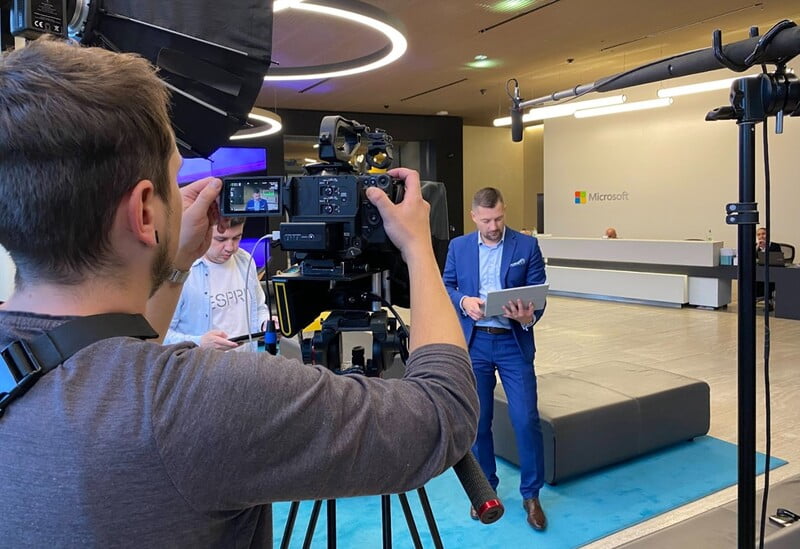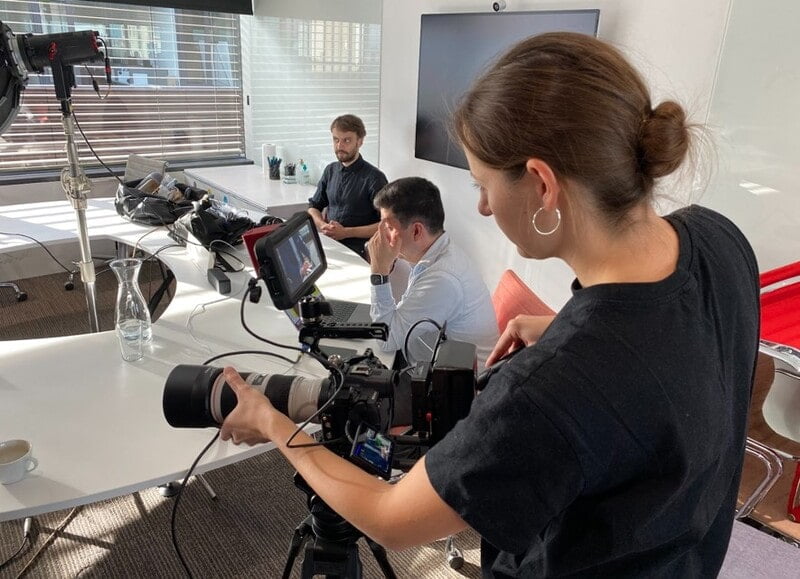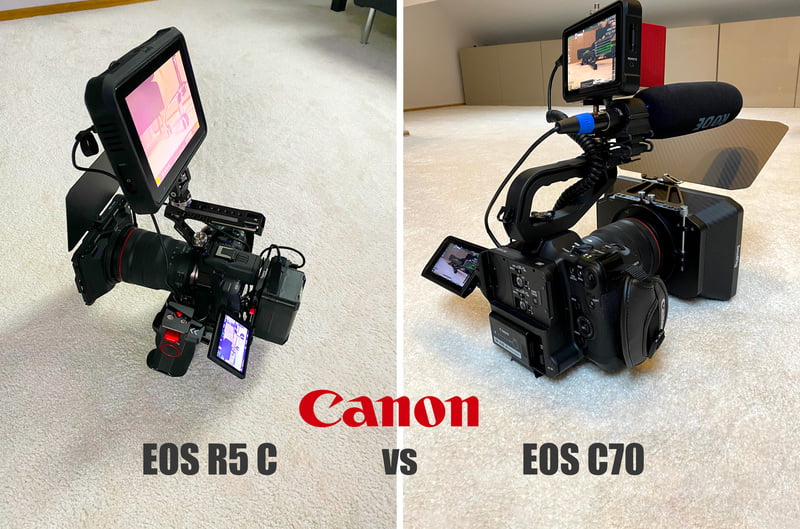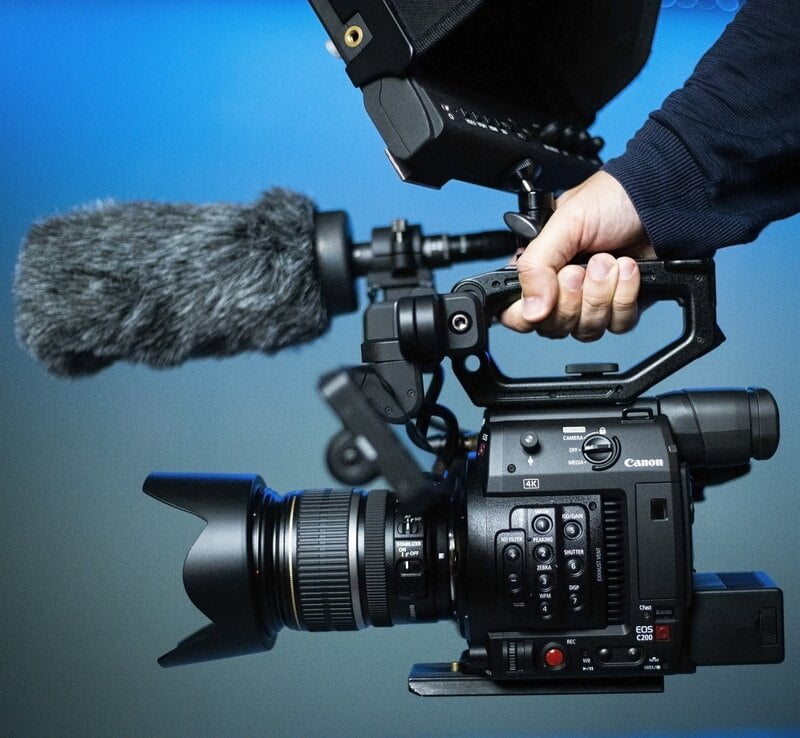When it debuted in 2017, the Canon C200 quickly gained fame as an affordable entry point into the Cinema EOS lineup. Fast-forward to 2025, and it’s still holding strong in many filmmakers’ kits.
You might wonder if such an “older” camera can keep up with current requirements—and my answer remains it depends. Video production is highly personal, and your choice hinges on budget, workflow, and the type of projects you tackle.
This expanded post digs into everything you need to know about the Canon C200 in 2025: from cost-effectiveness and image quality, to audio capabilities and workflow benefits.
We’ll also look at how it stacks up against newer cinema cameras like the C70 and C80—without letting the newer hype overshadow the reliability and proven performance of the C200.
Ask yourself this, “What do I value?”
From a price-to-performance angle, the Canon C200 is still among the best cinema cameras on the market. In 2025, you’ll find it floating around $2,000-$3,000 used on reputable camera marketplaces or eBay, depending on the condition and included accessories. Those prices can fluctuate, but it remains a tempting option for a full-fledged cinema rig.
Not everyone needs a professional cinema camera, of course. If you’re just starting out, a smartphone or compact mirrorless might do fine. However, for those yearning to explore RAW recording, integrated XLR inputs, and a user-friendly cinema workflow, the C200 packs a lot of punch into an aging—but undeniably capable—body.
What type of videos are you shooting?

The Canon C200 is relatively bigger compared to Canon’s mirrorless R line, and even bigger than the C70 or the more recently released C80. While it’s not unwieldy, it’s noticeably heavier than a DSLR or mirrorless camera, which might matter for corporate event or wedding shooters who value portability.
If you also need pro photography in the same body, you may lean towards a hybrid camera (e.g., R5 or R6). But if your main goal is capturing robust video with dedicated cinema features (like built-in ND filters, advanced audio inputs, and easy rigging), the C200 stands tall.
If you’re more of a run-and-gun filmmaker who demands a lighter setup, the C70 or C80 might tempt you with their compact form factors. However, for stationary interviews, corporate shoots, or documentary work off a tripod or shoulder rig, the C200’s slightly larger body can actually improve handling and heat dissipation.
Budget is another factor. If your year-end profits support expensive equipment, you can indulge in a brand-new cinema line setup. But if you’re operating lean and value proven reliability, a used C200 might be your ideal solution, even in 2025.
Exploring the Canon C200: Why It’s Still Relevant in 2025
The Canon C200, released in mid-2017, defies the typical “camera life cycle” expectations. Many older digital cinema models get phased out or overshadowed by updated sensors, codecs, and feature sets.
Yet the C200 retains a loyal following thanks to its internal RAW (Cinema RAW Light), full-size XLR inputs, SDI out, and Canon’s signature color science. Moreover, you can edit its RAW format in popular NLEs relatively smoothly nowadays—something that felt cumbersome back in 2017.
Even with the arrival of cameras like the Canon C70 and Canon C80, the C200’s blend of familiar workflows, robust body construction, and straightforward menu system makes it a top contender for those seeking a cost-effective cinema experience. Let’s dissect exactly where it shines—and where it might fall short if you’re chasing the newest features.
Cost-Effectiveness and Features
One of the biggest draws of the Canon C200 in 2025 is affordability. You can often find one under $2,000 on the used market. That’s an astonishing price for a cinema camera packing a robust feature set:
- 4K up to 60 fps in Canon’s trusty Cinema RAW Light (though at large file sizes).
- Full-size XLR inputs for professional audio.
- Solid ergonomics, built-in ND filters (2, 4, 6, 8, 10 stops), and a modular design that easily supports top handles, external monitors, and larger battery options.
- Dual Pixel Autofocus (DPAF) with face-only mode, which remains reliable for interviews and talk-to-camera shots.
- SDI out, an EVF, and a fully articulating LCD screen for flexible monitoring.
Compare that to brand-new cinema cameras: you’ll likely pay double or triple the price to get a near-equivalent set of features—if you factor in media costs and the potential need for add-on audio modules.

For many, the C200’s price-value ratio still sets it apart. It’s also a simpler transition if you already own EF lenses or have an EF-lens-based ecosystem.
If you run a smaller video production company or freelance solo, the C200 can handle most professional tasks without draining your account. For daily corporate interviews, YouTube content, or smaller commercial work, it delivers all the performance you need in a stable, time-tested package.
Removing the Hype: How It Compares to the Canon C80 on Price
The Canon C80 is a fresh face in the Cinema EOS lineup, sporting a full-frame 6K sensor (closely resembling certain specs from the Canon R3), triple base ISO, and options for RAW or 4K oversampled from 6K.
It’s priced notably higher than a used C200, but it also brings advanced features like built-in Wi-Fi, updated autofocus modes (including animal detection), and refined ergonomics.
However, if your concern is budget, a used C200 may remain unmatched. The C80’s triple base ISO and 6K capture are attractive, yet those come at a premium. If your workflow doesn’t demand the extra resolution or advanced low-light performance, the older C200 could be a more wallet-friendly choice.
Image Quality and Sensor Performance
Resolution and frame rates aren’t everything. Canon’s “secret sauce” frequently lies in their color science and sensor design. The C200’s Super 35 sensor captures an aesthetically pleasing image, with great skin tones and decent dynamic range.
On paper, it might be overshadowed by the latest 6K or 8K sensors, but in real-world side-by-side comparisons, the footage remains quite cinematic.
Color reproduction also continues to impress. Canon’s approach to hue and contrast often requires minimal grading to achieve a vibrant, natural look. If you’re filming corporate interviews or brand testimonials, the C200’s eight-bit files (in MP4 or MXF) can still look fantastic once compressed for online platforms.
Of course, if you want maximum latitude in post, you can leverage Cinema RAW Light for 12 or 14-bit color data—though prepare for large file sizes and the necessity of faster CFast 2.0 cards.
This classic sensor synergy is why some cinematographers still reach for the C200. As long as you expose properly, the resulting footage has that trademark Canon warmth that many clients and filmmakers appreciate.
If you compare it to the C80’s 6K full-frame readout, you may see sharper details or less rolling shutter on the newer camera, but the C200’s visuals stand up, especially if final delivery is in 4K or lower.
Comparing Dynamic Range: C200 vs. C80
The Canon C80’s newer sensor architecture and triple base ISO promise improved low-light performance and dynamic range in certain scenarios. Based on real-world tests, the C80 can indeed clean up noise effectively once you cross certain ISO thresholds (e.g., 3200 or 12,800).
The C200 lacks dual or triple base ISO; it’s more traditional, so you’ll see some noise if you try to underexpose too aggressively.
In highlight roll-off, the older C200 still does a commendable job. However, if you plan to shoot high-contrast scenes and rescue deeply shadowed areas in post, the C80’s sensor might give you a slight edge. That said, every dynamic range “win” needs to be weighed against cost, personal workflow preferences, and how often you truly need those extra stops.
Simply put, the C80 may provide a modest advantage in shadow detail if you regularly push your ISO. But if you light your subjects well and stay within normal exposure conditions, the C200’s dynamic range remains more than sufficient for commercial or documentary projects.
Audio Capabilities and Workflow
Though resolution and DR get the spotlight, audio can make or break a production. The C200 comes with two full-size XLR inputs—no adapters needed. This convenience is especially critical for documentary and interview shooters who rely on professional mics.
The camera’s preamps are quite clean at moderate gain levels, giving you broadcast-quality sound in a straightforward, all-in-one setup.
C80 owners sometimes note that their camera uses mini XLR inputs, requiring special cables or adapters. The C70 also shares that limitation. Meanwhile, the C200’s standard XLR ports remain a big plus if you already have a library of standard XLR cables.
While the C80 is an improvement over older mirrorless bodies lacking XLR inputs entirely, you still can’t beat full-size XLR for seamless audio solutions.
Modularity further enhances workflow flexibility on the C200. You can rig it up with a top handle, external monitor, V-mount battery, and a matte box—or strip it down for a smaller footprint when needed.

If you’re not used to cinema cameras, keep in mind that the C200’s bigger shape helps accommodate its advanced internals and integrated features like internal ND filters.
While you can find some of these conveniences on the C80 or C70, the straightforward “all-in-one” approach on the C200 remains a major draw. You have everything you need right in the box to start shooting professional projects—no extra gear or modules required for standard interview setups.
Within our video production company in Prague, we often mix multiple cameras for different shoots. Despite the arrival of more compact models, the C200 still sees frequent use because it’s predictable, robust, and delivers consistently great imagery without demanding new rigs or accessories.
Evaluating Other Filmmaking Cameras
If you’re lens-agnostic, you could explore Sony’s popular mirrorless lineup or Panasonic’s Micro Four Thirds options (like the GH6). Yet for anyone already invested in Canon EF glass, the C200 presents a near-perfect synergy. Canon’s lens ecosystem remains vast—plus, used EF lenses are generally more affordable than their RF counterparts.
While the Canon RF mount is the future (C70, C80), the EF mount’s maturity offers cheaper lens choices, and the difference in “look” may not justify buying an entirely new lens set. Additionally, adapters can bring EF lenses onto RF cameras, but that adds to the cost and complexity.
Canon EOS C200 vs. C70
Before we dig deeper into the C80, let’s remember the C70 also drastically shifted the Canon cinema family by embracing the RF mount and introducing 10-bit 4:2:2. Depending on your usage, the C70 might overshadow the C200 for run-and-gun projects, but many filmmakers still prefer the C200’s body style, integrated EVF, or raw recording approach.
Reasons to opt for the Canon EOS C70 Cinema Camera:
- The Canon C70 offers 10-bit 4:2:2 internal recording, while the C200’s standard formats are 8-bit unless you switch to RAW.
- Dual Gain Output (DGO) sensor for enhanced dynamic range, stronger highlight retention, and cleaner shadows.
- False color in-camera, allowing quick exposure assessments.
- RF lens compatibility, plus the option for a full-frame EF-to-RF adapter.
- Compact body—ideal for travel or small crew shoots.
- Uses only SD cards (no CFast needed, although you might need V90 for high data rates).
- Simultaneous full and proxy quality recording, easing post-production workflows.
- Slow motion up to 180 fps in 1080p (120 fps on the C200 lacks AF and is limited to 1080p).
- Touchscreen LCD for intuitive focus control.
- Better battery life overall.
- Timecode sync for multi-camera setups.
Reasons to go for the C200:

- Modular cinema camera ergonomics with more mounting points, optional EVF usage, and that “big camera” professional look that some clients recognize immediately.
- Very rugged build quality.
- SDI out (often preferred over HDMI in certain production environments).
- Native internal RAW recording (Cinema RAW Light), giving advanced color flexibility. (C70 added RAW later via firmware, but the C200 had it from day one.)
- Full-size XLR inputs—no mini XLR adapters needed.
- Includes an electronic viewfinder, beneficial in bright outdoor conditions.
Canon C200 vs. C80: Full-Frame or Super 35?
New to the conversation is the Canon C80, which builds on lessons from the C70 while introducing a full-frame 6K sensor, triple base ISO, and advanced output options. Here’s how the C200 and C80 compare on several points:
Full-Frame vs. Super 35
The C200 uses a Super 35 sensor limited to 4K, while the C80 is full-frame and can capture 6K RAW. Full-frame shooters enjoy a wider field of view and shallower depth of field, but lens choice becomes crucial—especially if you already own EF glass. The C200’s smaller sensor remains perfectly adequate for cinema production, but if you crave that full-frame aesthetic, you might gravitate toward the C80.
Dynamic Range & Low-Light Performance
The C80’s triple base ISO gives it an edge in certain low-light or high-contrast scenarios. You can shoot at base ISO 800, 3200, or 12,800 to minimize noise. The C200, being older, lacks advanced base ISO switching. If you often find yourself shooting in dim venues or want maximum highlight and shadow flexibility, the C80 has an advantage.
Audio Inputs
The C80 employs mini XLR ports, while the C200 offers full-size XLRs. If you already own standard XLR cables, the C200’s audio setup might streamline your workflow. Of course, if you don’t mind mini XLR or plan to adapt anyway, the difference may be negligible.
File Formats and Media
The C80 can record 6K RAW or 4K oversampled from 6K for greater clarity. The C200, by contrast, does 4K or 1080p, with Cinema RAW Light reserved for 4K. C80 also uses SD cards, albeit needing top-tier cards for higher bitrates, whereas the C200 demands CFast 2.0 for RAW but can use SD for MP4/MXF. For some users, that media difference is huge: modern CFexpress is not supported on either camera, which might be a sticking point if you’re used to super-fast data transfer. However, for many on a budget, cheap SD or used CFast might be simpler than brand-new CFexpress B cards.
Price and Conclusion
Brand-new, the C80 is pricier than a used C200—sometimes by a few thousand dollars, depending on your region. If full-frame, triple base ISO, and more modern design aren’t essential, the C200 can save you a lot of money while still delivering high-end results. If those new features seem irresistible (especially if you’re consistently in challenging low-light shoots), the C80 might justify the extra cost.

Key Takeaway
If you already own EF glass, love the proven look of the C200, and want a bargain cinema workhorse, stick with or invest in the C200. If you need full-frame or advanced ISO performance for specialized tasks—and have the budget—the C80 can be worth it. Either way, you’re getting a robust Canon Cinema EOS tool with that classic color science.
Limitations and Considerations
Despite its many strengths, the C200 isn’t perfect. Here are some factors to keep in mind:
- 120 fps slow motion is limited to 1080p and disables autofocus. Compare that to the C70 or C80, which have more robust high-frame-rate modes (though with caveats of their own).
- Large RAW file sizes: Cinema RAW Light is a big improvement over older Canon RAW, but it’s still hefty. You’ll need substantial storage and computing power for frequent RAW shoots.
- 8-bit internal (non-RAW) codecs: Some productions or colorists might demand 10-bit. The C70 and C80 handle 10-bit 4:2:2 natively, but the C200 only does that in RAW, which may be overkill for certain workflows.
- CFast 2.0 for RAW: The card type remains functional but is less common today. If you’re not filming RAW, you can stick to cheaper SD cards (though the camera’s top-end bitrates require higher-performance SDs for reliability).
Even so, these limitations aren’t deal-breakers for many. If you work in controlled lighting, rely mostly on 24/30/60 fps, and prefer simpler file management, the C200’s 8-bit or RAW pipeline remains a strong proposition for 2025.
Autofocus and Usability
The original Dual Pixel Autofocus (DPAF) on the C200 once dazzled. Today, cameras like the C70, C80, and even mirrorless R-series bodies push AF capabilities further, with improved subject tracking and sometimes eye-detect features.
The C200’s “face-only” mode is still quite handy: if it loses a subject’s face, it simply holds focus without hunting. That’s a boon for static interviews.
However, if you need quick or advanced autofocus shifts—for instance, filming fast-moving subjects—newer cameras might outperform the older DPAF. Manual focusing remains a standard in cinema anyway, so this might not matter if you shoot narrative or doc-style with a dedicated focus puller.
But for solo operators, keep in mind that the C200’s autofocus, while solid, isn’t as advanced as the newer dual pixel technologies found in the C70 or C80.
Also, tapping-to-track an object is less seamless on the C200’s older interface compared to the slicker touchscreen focus in modern Canon cameras. That said, you’ll still find DPAF a life-saver for typical corporate talking heads, product demos, or YouTube content where you’re not constantly re-framing focus points on the fly.
Canon EOS C200 vs C70 vs C80: Which One Should You Choose in 2025?
In short, it depends on your priorities:
- Need Full Frame + Triple Base ISO? The C80 might suit you. But budget carefully, as the cost is notably higher than a used C200.
- Value 10-bit 4:2:2, an RF mount, and Dual Gain Output for dynamic range? The C70 stands out, especially for run-and-gun shooters needing a lighter rig.
- Prefer an established setup with full-size XLRs, an EVF, and internal RAW from day one? The C200 is a classic—and at 2025 used prices, it could be the best bargain in Canon’s cinema stable.
Final Thoughts
Ultimately, your camera choice boils down to budget, existing gear, and specific production needs. In 2025, the Canon C200 stands strong as an excellent mid-range cinema option, especially if you’re mindful of your post-production workflow and don’t mind the older 8-bit codecs (or if you love RAW).
If you regularly shoot in well-lit environments and keep your ISO at a reasonable level, you probably won’t notice a major gap versus the C70 or C80 in final image quality.
If you can’t easily tell two cameras apart without checking EXIF data, your clients likely can’t either. The key difference is how much you value newer features like advanced autofocus, higher ISOs, or an RF mount. Many professionals continue to choose the C200 because it checks the boxes for reliability, color rendition, and user-friendly design, at a used price point that’s hard to resist.
With that being said, consider which features are must-haves.
Do you outsource your video editing?
If you do, you may need proxy recording capabilities (like on the C70) to speed up remote collaborations. Otherwise, you’ll spend time converting RAW or large files yourself—or pay for extra cloud-based transfer solutions. For slow-motion fanatics, the C200’s 120 fps might feel limited compared to the 180 fps or 6K-based options on newer cameras.
Still, if you find a well-priced used C200 at around $2,000, that’s a phenomenal deal for a proven workhorse. I know many content creators and corporate video specialists who’ve thrived with this camera for years without a hitch.

We also recommend reading our newest similar blog post “Canon C70 vs R5 C: An Owner’s Perspective on Both Cameras“
When working with a camera crew, uniformity matters, so matching the camera brand and codec can simplify your color correction. If you’re primarily solo, you may only require one robust body plus a mirrorless backup. Either way, building redundancy into your system is wise—especially for crucial, once-in-a-lifetime events where no retakes are possible.
Above all, the Canon C200 is a testament to Canon’s knack for building cameras that stay relevant. Even in a market brimming with 6K, 8K, and high-frame-rate shooters, the C200 still checks many boxes for professionals who value consistent, high-quality output.
Conclusion and Recommendations
In 2025, the Canon C200 remains a stellar option for those seeking reliability, professional audio connections, and a direct path to cinema-quality footage. The sensor may not be the newest, but it’s proven. The 8-bit codec might not wow specs-enthusiasts, but it’s serviceable for the majority of online deliveries, and the RAW option is always there when you need deeper color fidelity.
If you want a camera that’s easy to scale, with full-size XLRs, integrated NDs, and a robust build, the C200 is hard to beat.
If you absolutely require higher resolutions, more dynamic range, or modern autofocus tracking, consider the C80 or C70. But you’ll pay more, and you might not gain as much as you think—depending on your typical production demands.
Ultimately, the Canon C200’s staying power testifies to its cinematic look, straightforward operation, and cost-effectiveness. From documentary and corporate to event filming and YouTube content, it covers a wide range of needs. If that profile aligns with what you do, it’s still an excellent buy in 2025.


